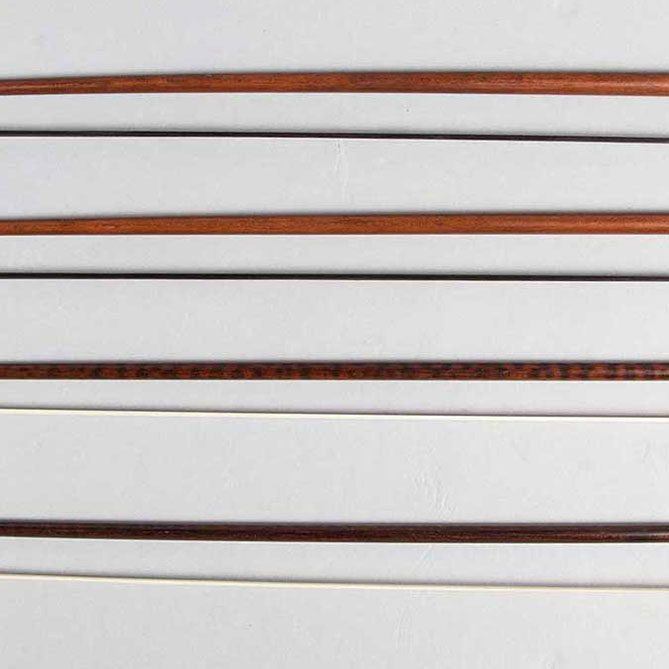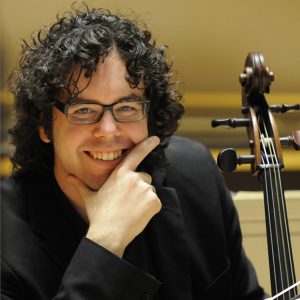
On How to Play the Baroque Cello: the Baroque Bow, or What Your Ear Imagines Your Bow Should Do (Part 2)
Guy Fishman
For the continuation of my brief discussion of the baroque bow, I’d like to begin by listing several descriptions that I believe only faintly hide a prejudice towards it as a primitive tool. “The baroque bow is for speaking, while the modern bow is for singing.” “The baroque bow articulates while the modern bow sustains.” “The baroque bow makes a lean, silvery tone, while the modern bow creates a round, lush sound.” And my favorite, “the baroque bow naturally weakens as it is pulled towards the tip.”
Before I continue, a quick reminder of two things I mentioned in my previous post: first, what your ear imagines, your bow should be able to do. That last description is usually left where it ends because in this case, the comparison to the modern bow should obviously result in “…while the modern bow does not,” which is, in fact, untrue. As a bow of any period and design is pulled and the hand—the source point of the arm’s weight—moves away from the string, the sound will diminish, if it is allowed to. Just as you can sustain the sound on a modern bow, you can do so with a baroque bow, if you wish. And judging by continuo lines in several types of works—Corelli’s violin sonata in D major, op. 5, no. 1, for instance—a cellist would have been required to sustain the sound without diminishing, even in 1700.
The second reminder is of those cellists who used their baroque bows for kindling their fires when cooking dinner. Certainly, they thought the baroque bow was primitive, and discarded it as soon as they bought a brand new bow, if they could afford one. As a new Tourte bow in 1800 could cost around $35,000 in today’s currency (holding an economic power far, far greater than in today’s markets), it’s unlikely everyone could afford a new “modern bow.” Undoubtedly, Beethoven heard some of his early symphonies performed by string sections that included players using “baroque” bows. But that’s not to say they didn’t want a new and supposedly improved bow.
Of course, these players didn’t spend much time playing Bach and Vivaldi, and certainly not Biber and Monteverdi. The public demanded the newest music, and players sought to perform it on the newest equipment. When Bach’s unaccompanied suites for cello were first published, in 1824, the editor did not recommend that the player take up a baroque bow. One may not have been able to locate such a bow even if he or she wanted to. And what for? Considerations for historical accuracy are a decidedly twentieth century phenomenon, and besides, the cello of 1824 bore more resemblance to the cello of a hundred years prior than does the standard cello of today. The point is, these folks had no reason to keep their old bows, and every reason to eat a warm dinner. But their priorities were different than yours, and since you are interested in playing the “baroque” cello, here is what you might consider and encounter when first using a baroque bow.
The first things that struck me when I tried my first baroque bows were the shape and the wood. I have interviewed several prominent archetiers in preparation for this blog, and as for the wood, all agree that several types of wood were used, of a sort that was heavy but perhaps less stiff than Pernambuco. These include Ironwood, also known as Banya; Ebony; African Blackwood; and Snakewood, the preferred wood, according to Harry Grabenstein. For comparison, he says that a modern bow made of Snakewood would feel “too heavy and mushy.” Louis Bégin contends that Pernambuco was not used until the start of the 19th century. I have not seen an Ebony bow, but certainly have come across fine samples made out of all of the aforementioned woods.
As far as the design, there is a wide spectrum of choices available that reflects the beliefs, imaginations, and talents of the many archetiers active in supplying bows to today’s period performers. The reason is three-fold. First, human ingenuity is a force of nature and were Stradivari himself to appear and declare one bow design superior to all others, personal predilection on the part of both maker and player would all but guarantee that, while some would certainly make the “Stradivari” model, others would continue to experiment with their own designs. Second, making a living as a musician in the seventeenth and eighteenth century was hard, and one often had to be adept at several instruments in order to survive. Cellists often played gambas, and vice versa (here is cellist/gambist Wieland Kuijken playing a baroque cello, with endpin, and using a gamba bow). They may have used the same bow for both instruments, and in any event, identifying extant early models as having been used exclusively as either a cello or gamba bow is virtually impossible. And third, there simply aren’t many—or any—surviving cello bows from before about the middle of the 1700s.
Two characteristics of the baroque bow account for the majority of variation between different models amongst makers. These are length and camber. I confess I am somewhat disinterested in the various lengths of bows. I believe makers made what was practical and what was asked for by players. There is no doubt that violinists during much of the 17th century owned several bows, short for fast dances, long for sonatas and sustained music. It is generally agreed upon by the makers I interviewed that we do not have a cello bow from this period. Some of them only make later (longer) models, and some extrapolate models by essentially making violin bows for the cello, based on surviving samples, iconography, and their own ingenuity. There are good qualities to these bows, to be sure. But for me, it is impractical to own several bows for music written before the first known solo works for cello were composed by Degli Antonii, Jacchini, and Gabrielli in 1680s Bologna. This is music that is served just as well by my later bow as it is by shorter models.
However, camber is a matter of much discussion and often a somewhat divisive issue. David Hawthorne described to me a bow he had seen belonging to Charles Beare in London. He believed it was made in the 1690s, making it the earliest bow seen by any of the makers who contributed here. He described it as somewhat shorter, and with an outward camber, much like some of the violin bows seen in early paintings, and like some of the samples that survive. However, Hawthorne made the important point, supported by Ralph Ashmead, that wood tends to gain outward camber over time. In other words, it is impossible to accurately ascertain what the bow may have looked like when it was made. It could have mimicked violin models in its outward camber but have had that camber increased over time. Or, it may have been virtually straight or cambered inwards as a modern bow is. There is no way to know.
What is knowable is that bows with different types of camber function differently. Of course, a relativistic but not incorrect reply to that assertion is that bows with the same type of camber also function differently, depending on many factors, including the maker. But there are players that swear by straight bows, and others who favor cambered bows of both types, and makers who accommodate the needs of all of them. In my next blog post, I will attempt to relate some of my own experiences with the baroque bow, that is, how one might actually play one.
Subjects: Baroque, Historical

